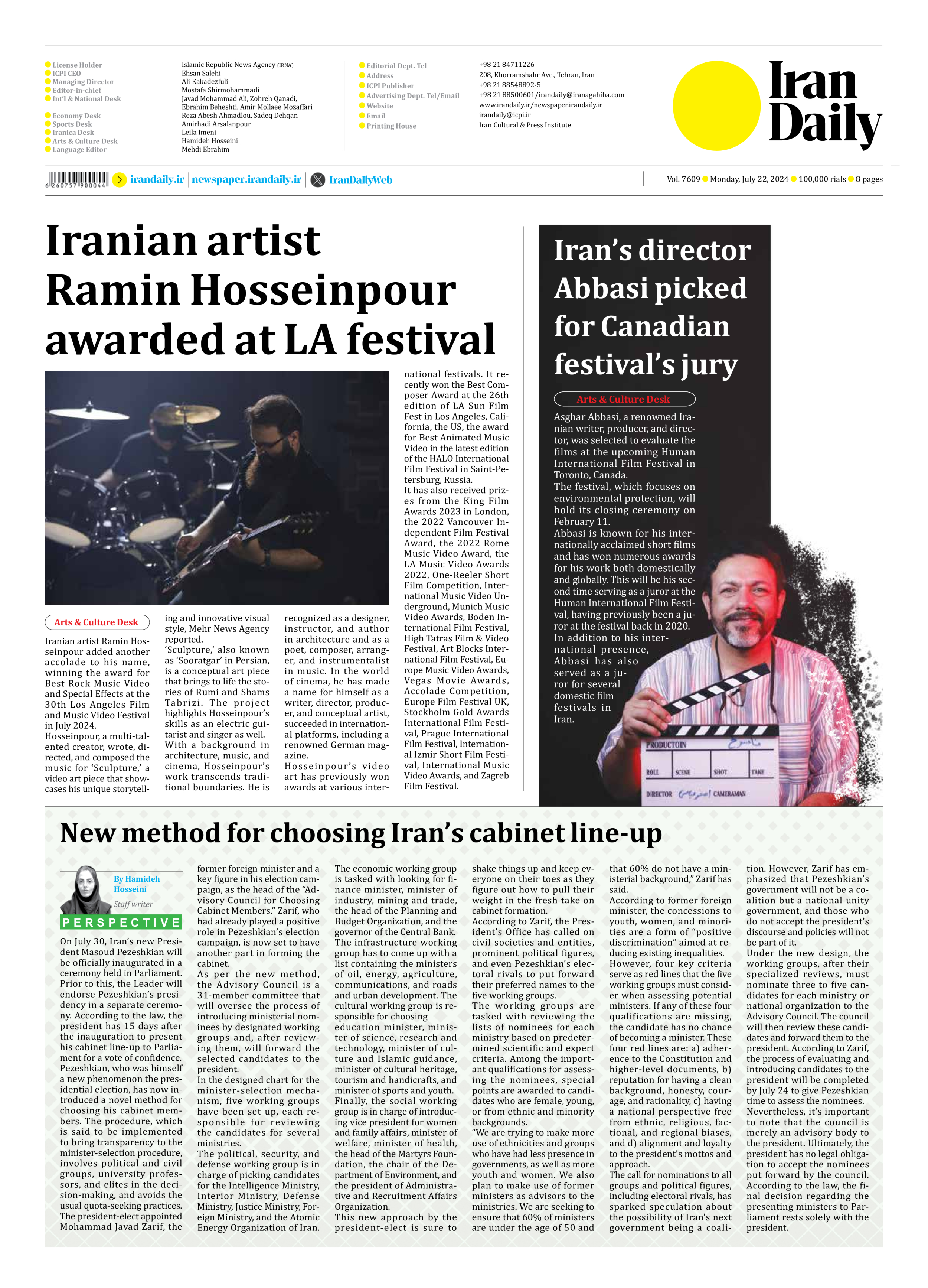
New method for choosing Iran’s cabinet line-up
By Hamideh Hosseini
Staff writer
On July 30, Iran’s new President Masoud Pezeshkian will be officially inaugurated in a ceremony held in Parliament. Prior to this, the Leader will endorse Pezeshkian’s presidency in a separate ceremony. According to the law, the president has 15 days after the inauguration to present his cabinet line-up to Parliament for a vote of confidence.
Pezeshkian, who was himself a new phenomenon the presidential election, has now introduced a novel method for choosing his cabinet members. The procedure, which is said to be implemented to bring transparency to the minister-selection procedure, involves political and civil groups, university professors, and elites in the decision-making, and avoids the usual quota-seeking practices.
The president-elect appointed Mohammad Javad Zarif, the former foreign minister and a key figure in his election campaign, as the head of the “Advisory Council for Choosing Cabinet Members.” Zarif, who had already played a positive role in Pezeshkian’s election campaign, is now set to have another part in forming the cabinet.
As per the new method, the Advisory Council is a 31-member committee that will oversee the process of introducing ministerial nominees by designated working groups and, after reviewing them, will forward the selected candidates to the
president.
In the designed chart for the minister-selection mechanism, five working groups have been set up, each responsible for reviewing the candidates for several
ministries.
The political, security, and defense working group is in charge of picking candidates for the Intelligence Ministry, Interior Ministry, Defense Ministry, Justice Ministry, Foreign Ministry, and the Atomic Energy Organization of Iran. The economic working group is tasked with looking for finance minister, minister of industry, mining and trade, the head of the Planning and Budget Organization, and the governor of the Central Bank.
The infrastructure working group has to come up with a list containing the ministers of oil, energy, agriculture, communications, and roads and urban development. The cultural working group is responsible for choosing
education minister, minister of science, research and technology, minister of culture and Islamic guidance, minister of cultural heritage, tourism and handicrafts, and minister of sports and youth.
Finally, the social working group is in charge of introducing vice president for women and family affairs, minister of welfare, minister of health, the head of the Martyrs Foundation, the chair of the Department of Environment, and the president of Administrative and Recruitment Affairs Organization.
This new approach by the president-elect is sure to shake things up and keep everyone on their toes as they figure out how to pull their weight in the fresh take on cabinet formation.
According to Zarif, the President’s Office has called on civil societies and entities, prominent political figures, and even Pezeshkian’s electoral rivals to put forward their preferred names to the five working groups.
The working groups are tasked with reviewing the lists of nominees for each ministry based on predetermined scientific and expert criteria. Among the important qualifications for assessing the nominees, special points are awarded to candidates who are female, young, or from ethnic and minority backgrounds.
“We are trying to make more use of ethnicities and groups who have had less presence in governments, as well as more youth and women. We also plan to make use of former ministers as advisors to the ministries. We are seeking to ensure that 60% of ministers are under the age of 50 and that 60% do not have a ministerial background,” Zarif has said.
According to former foreign minister, the concessions to youth, women, and minorities are a form of “positive discrimination” aimed at reducing existing inequalities.
However, four key criteria serve as red lines that the five working groups must consider when assessing potential ministers. If any of these four qualifications are missing, the candidate has no chance of becoming a minister. These four red lines are: a) adherence to the Constitution and higher-level documents, b) reputation for having a clean background, honesty, courage, and rationality, c) having a national perspective free from ethnic, religious, factional, and regional biases, and d) alignment and loyalty to the president’s mottos and
approach.
The call for nominations to all groups and political figures, including electoral rivals, has sparked speculation about the possibility of Iran’s next government being a coalition. However, Zarif has emphasized that Pezeshkian’s government will not be a coalition but a national unity government, and those who do not accept the president’s discourse and policies will not be part of it.
Under the new design, the working groups, after their specialized reviews, must nominate three to five candidates for each ministry or national organization to the Advisory Council. The council will then review these candidates and forward them to the president. According to Zarif, the process of evaluating and introducing candidates to the president will be completed by July 24 to give Pezeshkian time to assess the nominees.
Nevertheless, it’s important to note that the council is merely an advisory body to the president. Ultimately, the president has no legal obligation to accept the nominees put forward by the council. According to the law, the final decision regarding the presenting ministers to Parliament rests solely with the president.







